The Columbus Blue Jackets and Toronto Maple Leafs were surprisingly even-matched this season despite having significantly different expectations.
Artemi Panarin, Matt Duchene, and Sergei Bobrovsky all signed elsewhere, yet the Blue Jackets finished 25-22 in regulation games, matching Toronto’s .521 point percentage in this category. While the two teams look nearly identical in the standings, the similarities immediately end there.
The Blue Jackets play boring hockey. Seth Jones and Zach Werenski form a strong top-pairing on the back-end, and there’s significant depth behind them with David Savard, Vladislav Gavrikov, Ryan Murray, Dean Kukan, and Markus Nutivaara in the fold. Their defensive prowess doesn’t end there; forwards like Nick Foligno, Oliver Bjorkstrand, and Riley Nash are clear standouts in terms of limiting chances against. Despite boasting zero 50-point players this season, the Blue Jackets were able to match the Leafs in the standings by effectively limiting high-danger scoring chances against:
The Blue Jackets essentially took away the front of the net completely and finished with the third-lowest expected goals against per minute at 5v5. In addition, they finished ahead of just Detroit, Buffalo, and Winnipeg in terms of 5v5 expected goals for per minute. There was plenty of boring hockey in Columbus this season.
The Leafs will be trying to push the pace, use their skill, and have fans on the edge of their seats, while the Blue Jackets will be perfectly content if you nod off during the game. I’d like to tell you that Toronto’s high-powered offense found a way to overcome Columbus’ strong defensive play this season, but you’ll notice that the Leafs struggled to generate high-danger chances in the two games this year (shot maps retrieved from Evolving Hockey):
The Leafs will need to be careful not to settle for low-danger shots. The Blue Jackets actually give up a fair amount of shot attempts, but as you saw in the above graphics, they’re rarely grade-A chances. It’s almost as if Elvis Merzilkins and Joonas Korpisalo were practicing social distancing all season, as they’re not too used to seeing an opposing puck carrier within six feet of them. There’s a good chance that the Leafs lead in shots on most nights, but if they’re firing a bunch of weak point shots, they’ll be playing into Columbus’ game plan.
5v5 Matchups and John Tavares’ New Role

In his first playoff series as a Leaf last year, John Tavares was tasked with shutting down one of the best lines in hockey. Playing against David Pastrnak and Brad Marchand automatically places you in a defensive role, and the Leafs would have been happy to just break even against them.
Tavares’ role is bound to be different against Columbus. The Blue Jackets don’t have the same type of dominant first line as Boston, so the main focus will be on his offensive game. Opposing players will be more concerned with shutting down Tavares, rather than vice-versa. His goal is no longer to just break-even.
Columbus’ lack of high-end scorers should help Sheldon Keefe in the matchup game, as he can focus on playing his top lines as much as possible rather than being overly focused on who jumps over the boards for the Blue Jackets. He may have pulled the Matthews line off the ice once the Bergeron line stepped on, but he shouldn’t have to do that against any of the Pierre-Luc Dubois, Boone Jenner, or Alexander Wennberg lines.
In addition, if Keefe wants to stack a line with both Matthews and Tavares for the occasional shift, he can be reasonably confident in Alexander Kerfoot’s ability to handle the opponent on the next shift. If I’m coaching the Leafs, I’m playing the Matthews and Tavares lines major minutes, matchups be damned.
Toronto’s Secret Weapon

There are three ways to score on Columbus:
- Beat them at their own game (Find a way to be one of the few teams that can generate plenty of high-danger chances against them).
- Score on the power play.
- Convert on a high percentage of medium- and low-danger opportunities.
The first two are fairly obvious. If the Leafs generate plenty of high-danger 5v5 scoring chances, the offensively-weak Blue Jackets will be a massive underdog in this series. Power play success is always key in the playoffs, but the Leafs never seem to get many opportunities, and the officials always seem to put their whistles away in big moments. It doesn’t exactly take a rocket scientist to know that racking up high-danger chances at 5v5, and scoring on the power play, are keys to success.
That brings us to the third way to score on Columbus, which essentially amounts to “take what is given to you, and capitalize”. The Blue Jackets do give up an average amount of shot attempts; they just tend to be low- or medium-danger chances. For a player like Auston Matthews, scoring from the top of the faceoff circle isn’t a rare event, but the Leafs aren’t exactly loaded with high-end shooters.
Toronto’s secret weapon in this series is Nick Robertson. The 18-year old rookie excels at turning medium-danger scoring chances into goals, as he offers both a wicked one-timer and a deceptive wrist-shot. He’s more than capable of scoring from the top of the face-off circle (his teammates spent half of training camp raving about his shot). Columbus’ big defensemen certainly use their size and strength to their advantage in front of the net, but if they let Robertson fire off shots from medium-danger areas, they are going to have a bad time.
Getting some offense out of the bottom-six will be key for the Leafs in this series. Prior to the break, there were far too many nights where the Leafs looked like a two-line team, especially when Kerfoot was moved up to the top-six. Both Matthews and Tavares should have an edge against any line that John Tortorella throws out there, so if the Leafs bottom-six can add secondary scoring, the Blue Jackets will be in trouble.
I would play both Nick Robertson and Pierre Engvall over Frederik Gauthier. I did like the Moore-Gauhtier-Ennis line from last year’s playoff series, but Kyle Clifford and Jason Spezza don’t bring the same speed to the table. I’m also not sure that their skillsets complement each other well. A Clifford-Gauthier-Spezza line screams “slow and boring hockey” to me, and I think the Blue Jackets will happily take all of the slow and boring hockey that they can get.
I strongly believe in the “do what your opponent doesn’t want you to do” approach. Playing Gauthier over Robertson feels like punting from the 50-yard line on fourth-and-inches. I’d be looking to push the pace and stretch Columbus’ defense out as much as possible.
A Changed Blue Jackets Roster
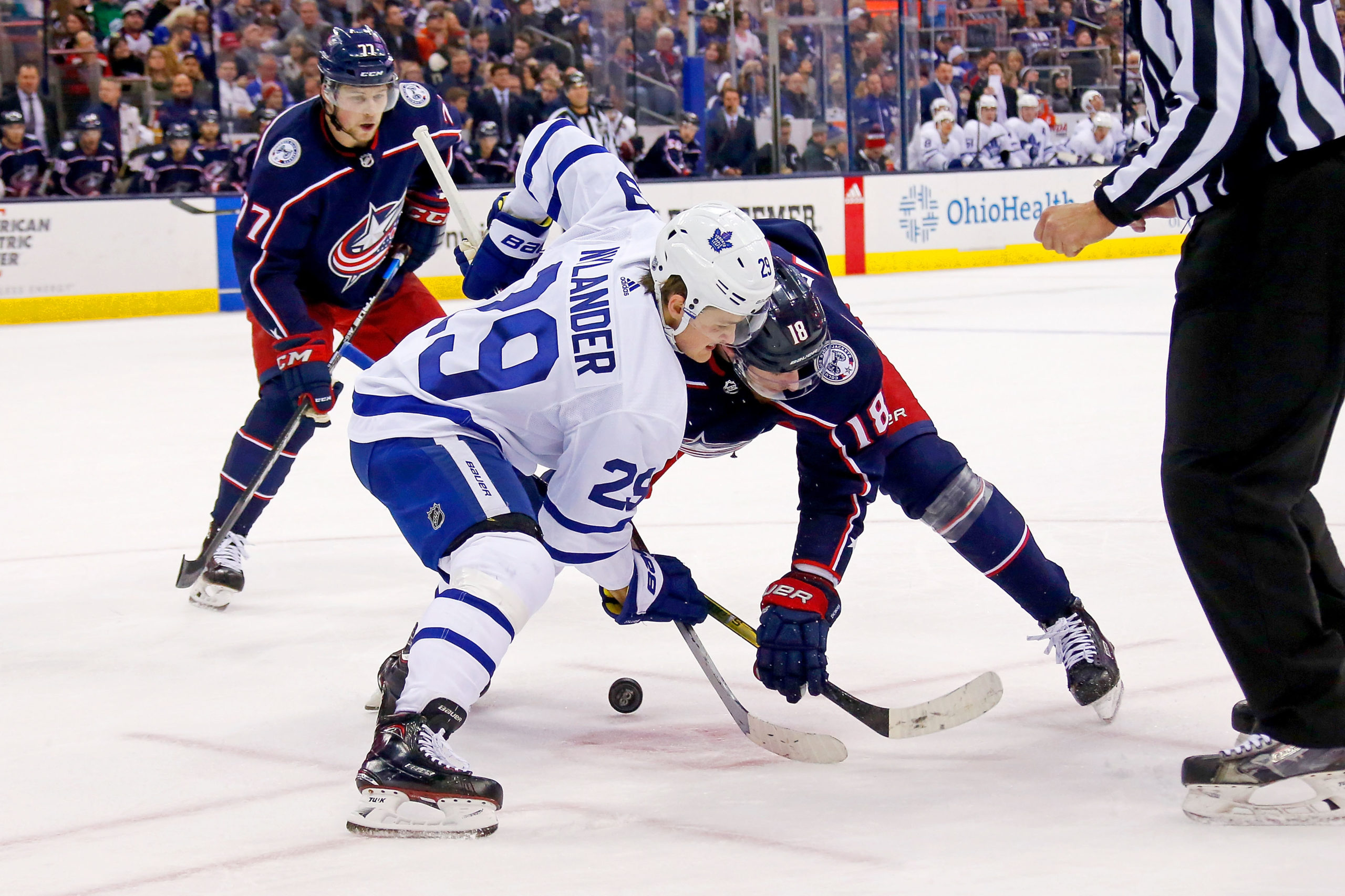
The Tampa Bay Lightning won 62 of 82 games a year ago, yet the Blue Jackets found a way to sweep them in four games. While the Blue Jackets are still a worthy opponent, especially in a short five-game series, it’s worth noting that they certainly aren’t quite as dangerous offensively as they were a year ago.
Artemi Panarin led the team in scoring in last year’s playoffs and is one of the best offensive players in all of hockey. Matt Duchene finished second on the team in playoff scoring, forming a strong 1-2 punch with Pierre-Luc Dubois up the middle. Josh Anderson, who usually torches the Leafs, is expected to miss the series due to injury. Obviously, the Leafs should not take this current Blue Jackets roster lightly (especially because of their defensive ability), but it would be foolish to watch last year’s team and expect to see the exact same pace of hockey.
CBJ at 5v5:
2018-2019:
GF/60: 2.75 (7th)
xGF/60: 2.36 (10th)
GA/60: 2.50 (19th)
xGA/60: 2.28 (17th)2019-2020:
GF/60: 2.16 (28th)
xGF/60: 2.20 (23rd)
GA/60: 2.11 (5th)
xGA/60: 2.04 (3rd)— Nick DeSouza (@NickDeSouza_) July 16, 2020
This current Blue Jackets team scores far less and generates fewer chances in terms of expected goals compared to last year’s roster. However, they also transformed from a slightly below-average team defensively to among the league’s best at preventing both goals and chances. You’ll still see a roster with big and strong defensemen as well as plenty of skilled forecheckers, but they are far less comfortable pushing the pace and far more inclined to sit back and play boring hockey.
Final Thoughts
- The Leafs need to be prepared to win 2-1 or 3-2. The Blue Jackets offense isn’t overwhelming, but if the Leafs lose their patience and make mistakes, there are certainly players who can capitalize. Toronto players should go watch their 2-1 victory over Boston in game five last year; that’s the perfect game to emulate. Columbus’ forward group is terrific defensively. It’s up to the Leafs to match their intensity and two-way game as much as possible.
- Toronto’s third line is a major key in this series. The Marleau-Nylander-Brown line from last year’s playoffs was not ideal. The Leafs also didn’t garner consistent enough production out of their bottom six this season. The Leafs should have the edge in the top six, so if the third line can win their matchup, the team is in great shape. At least two of Kerfoot, Kapanen, and Robertson should factor into the team’s second power play unit as well, which was dreadful last year against Boston. Kerfoot’s two-way game is a big reason why the Leafs acquired him. And you can usually count on Kasperi Kapanen to score a key breakaway goal or two.
- You don’t win the Stanley Cup with 12 forwards and six defensemen. If the Leafs are going to go on an extended run, you’re going to see players like Rasmus Sandin and Frederik Gauthier make an appearance, especially since there is now five rounds to get through rather than four within a condensed schedule. Tyler Ennis was on the outside looking in at the start of last year’s playoffs, but he ended up playing in five of Toronto’s seven games. Don’t be surprised to see plenty of different lineups throughout the course of the playoffs.
- Oh, and if you’re a key player on the Leafs, please don’t get yourself suspended.





















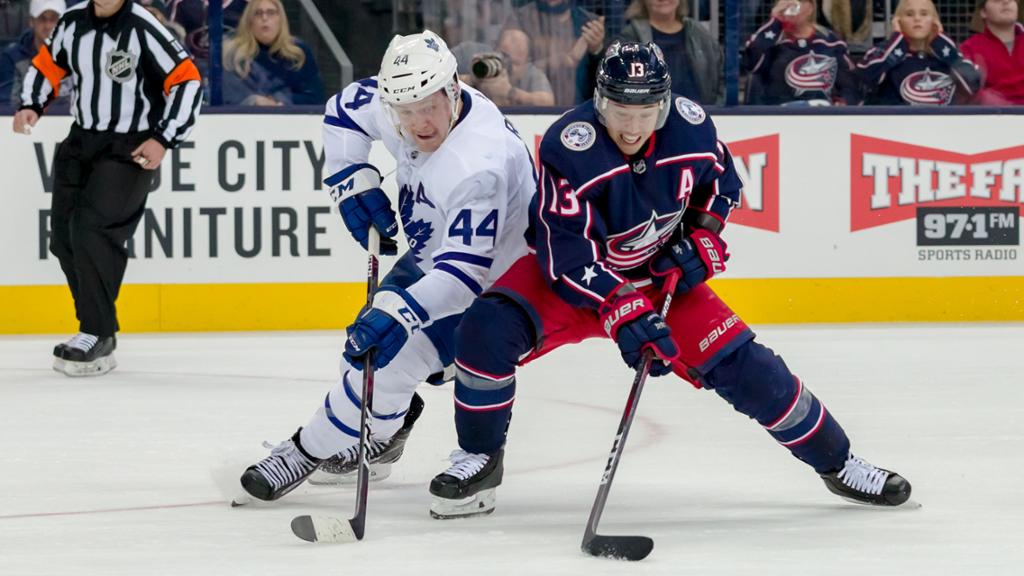
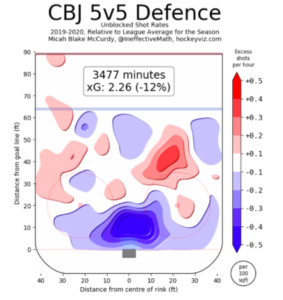 (Source: Hockeyviz.com)
(Source: Hockeyviz.com)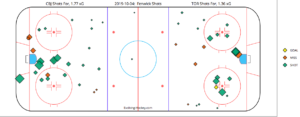
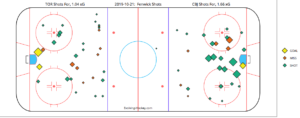








![New Leaf Anthony Stolarz on the opportunity in Toronto: “In Florida, I knew my role as a backup… Now, [Joseph Woll] and I are competing for starts… As a goalie, that’s all you can ask for” Anthony Stolarz, Stanley Cup win, now Maple Leaf](https://mapleleafshotstove.com/wp-content/uploads/2024/07/anthony-stolarz-sc-100x70.jpg)
